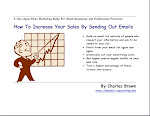Every freelance copywriter should own a copy of “Tested Advertising Methods,” written by the legendary copywriter, John Caples.
In the mid roaring twenties, 25 year old Caples made advertising history when he wrote the most famous ad of all time. It began with the words:
They laughed when I sat down at the piano.
But when I started to play---
That extraordinary ad for, of all things, mail order piano lessons, became the most successful, and most imitated ad of all time.
But apart from his remarkable writing talent, Caples changed advertising history in an even more profound way. Throughout his career, he pioneered the idea of rigorous, scientific testing for every element of ads and direct mail.
Every ad, every mailer was designated as either a test sample or a control sample. The control sample was usually the best performer from the previous test and not a single aspect of it was changed.
But the test sample was changed in one single way. It might have had a different headline, a different coupon, a different first paragraph, etc.
Then by comparing the results of the control and test samples, the ad or mailer could constantly be improved. In the next test run, the best performer of the two samples became the control for the next comparison.
Caples was such a strong advocate of testing because he saw how a campaign’s results could be dramatically improved. One time he tested to ads for the same product. Both ads were well written, both seemed to appeal to the target audience and both could have been chosen by many ad agencies as the final version.
But when the two ads were run side by side, one version pulled in 19 ½ more sales than the other.
Had this test never been run, the agency might have been pleased with the lesser ad’s results and run it for years.
So what things can be improved by testing? Here are a few:
- The headline. This is the most important element of any ad, mail piece or web page. Without testing, you are leaving it to chance.
- What picture or graphic produces the best results? Or would no image at all be best?
- Which publication(s) produce the most sales when the same ad is run side by side in competing magazines or newspapers?
- What appeal pulls in the most sales? The appeal is what hot button are you trying to push in the customer. Are you appealing to his need for security or his need for financial gain? Are you appealing to her need for sexual satisfaction or desire for adventure?
But how can the results of all this testing be compared? First, retail sales can provide the information needed. Laser-scanned bar codes at the checkout counter reports sales information instantly and in real time.
Another way that many consumer goods and fast food restaurants are tested is through test cities. I remember when McDonalds first introduced the breakfast burrito, I was in Indianapolis visiting my wife’s relatives. I tried the breakfast burrito and liked it. But when I got back home, I tried to order one from one of the local McDonalds and they looked at me as though I had green skin. The breakfast burritos were being tested in Indianapolis and no where else.
Finally there are key codes. If you look at a coupon for a typical direct mail ad, you will probably see something like, “Dept. XYZ.” I guarantee there is no department named XYZ at that company, but XYZ represents the key code for a particular version of the ad.
Despite the many decades of research demonstrating how testing improves the profitability of advertising, there are still many companies that spend mountains of money without testing. I hope they are winning industry awards for their creativity and the entertainment value of their ads, because their competitors will be making all the sales.
COPYRIGHT © 2006, Charles Brown
Labels: headlines, measurable advertising



0 comments:
Post a Comment